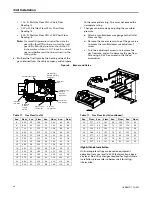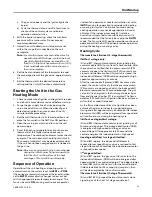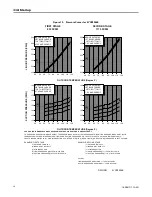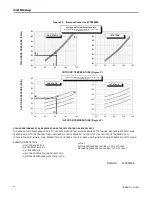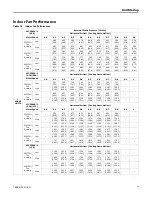
18-EB41D1-1A-EN
25
c. The gas valve opens and the ignitor lights the
burner.
d. Cycle the thermostat on and off a few times to
check out the control system and burner
operation characteristics.
4. With the burners operating, check the manifold
pressure with a manometer. Do not exceed
recommended pressures.
5. Adjust the unit to obtain an air temperature rise
within the range that is specified on the unit
nameplate.
N
No
otte
e:: For manifold pressures and orifice sizes for
gas with other BTU ratings, contact the local
gas utility. Manifold pressure should be 1.8
(low) to 3.5 (high) inches water column (+0.1).
Input must n
no
ott exceed the value shown on
the unit nameplate.
6. Set the heat anticipator of the thermostat to equal
the amperage draw of the gas valve, approximately
0.7.
7. Set the thermostat at the desired temperature
setting and the unit will function automatically.
Starting the Unit in the Gas
Heating Mode
1. Check to make sure all grilles and registers are open
and all unit access doors are closed before start-up.
2. Purge the gas supply line of air by opening the
union ahead of the unit. When the odor of gas is
detected, retighten the union and wait five (5)
minutes before proceeding.
3. Set the wall thermostat to its lowest position and
place the fan switch in the AUTO or ON position.
4. Open the main gas valve(s) and turn on the unit
power supply.
5. Reset the heating temperature lever on the room
thermostat at the highest value above room
temperature. The combustion blower motor should
energize. The main burners should light within 20-
25 seconds. Initial start may be delayed somewhat
if the unit has not been purged and air is trapped in
the gas line.
N
No
otte
e:: Blue smoke produced by the heat exchanger
during the initial burner firing is caused by a
thin film of oil on the surface of the heat
exchanger. This oil will burn off quickly.
Sequence of Operation
Operation of the unit heating and cooling cycles is
automatic when the system is set to H
HE
EA
AT
T or C
CO
OO
OL
L
(the optional automatic changeover thermostat, when
set to A
AU
UT
TO
O, automatically changes to heat or cool
with an appropriate room temperature change). The
fan can be set to O
ON
N, causing continuous evaporator
(indoor) fan operation at constant circulation or set to
A
AU
UT
TO
O causing fan operation to coincide with heating
or cooling run cycles. Continuous fan mode during
cooling operation may not be appropriate in humid
climates. If the indoor air exceeds 60% relative
humidity or simply feels uncomfortably humid, it is
recommended that the fan only be used in the A
AU
UT
TO
O
mode. The fan switch ON position provides continuous
operation while the AUTO position provides operation
during the heating or cooling cycles.
Heating Cycle
T
Th
he
errm
mo
osstta
att cca
allll ffo
orr h
he
ea
att (( 2
2--sstta
ag
ge
e tth
he
errm
mo
osstta
att))
C
Ca
allll ffo
orr 1
1
sstt
sstta
ag
ge
e o
on
nlly
y::
(R) and (W1) thermostat contacts close signaling the
control module (IGN) to run its self-check routine. After
the control has verified that the pressure switch (PS)
contacts are open, the limit switch (TCO) contacts are
closed, and the flame rollout (FL) switch is closed, the
induced draft blower (CBM) will be energized on high
speed for approximately 5 seconds.
After the induced draft blower (CBM) has come up to
speed, the control will verify that the pressure switch
(PS) contacts are closed and switch the induced draft
blower to low speed for 20 second prepurge. The gas
valve (GV) is energized in the first stage to permit gas
flow and the spark igniter (IP) is energized. The flame
detector (FD) confirms that ignition has been achieved
within the 7 second trial period.
As the flame detector confirms that ignition has been
achieved the delay to indoor fan on period begins
timing and after approximately 45 seconds, the indoor
blower motor (IDM) will be energized at low speed and
will continue to run during the heating cycle.
C
Ca
allll ffo
orr 2
2
n
nd
d
sstta
ag
ge
e a
afftte
err 1
1
sstt
sstta
ag
ge
e::
(R) and (W2) thermostat contacts close signaling a call
for second stage heat. The induced draft motor (CBM)
is energized on high speed and the gas valve on
second stage. After approximately 30 seconds the
control energizes the indoor blower on high speed.
2
2
n
nd
d
sstta
ag
ge
e ssa
attiissffiie
ed
d,, 1
1
sstt
sstta
ag
ge
e ssttiillll cca
alllle
ed
d::
(R) and (W2) opens, the induced draft blower is
reduced to low speed the gas valve is reduced to first
stage. After about 30 seconds the indoor blower motor
is reduced to low speed.
1
1
sstt
sstta
ag
ge
e ssa
attiissffiie
ed
d::
(R) and (W1) opens, the gas valve (GV) will close. The
induced draft blower (CBM) will be de-energized after
approximately 5 seconds postpurge. The indoor blower
motor (IDM) will continue to run for the fan off period
(field selectable 60 or 90 seconds [by jumpers]), then
will be de-energized by the control module.
T
Th
he
errm
mo
osstta
att cca
allll ffo
orr h
he
ea
att ((1
1--sstta
ag
ge
e T
Th
he
errm
mo
osstta
att))
(R) and (W1/W2) (jumped) thermostat contacts close
signaling a call for heat. 1st stage sequence of










